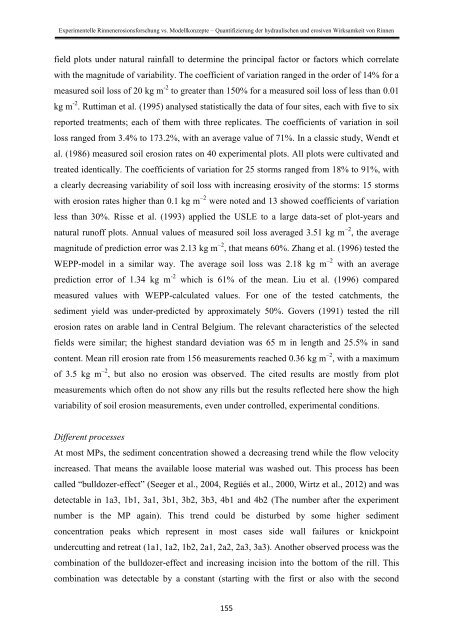Stefan Wirtz Vom Fachbereich VI (Geographie/Geowissenschaften ...
Stefan Wirtz Vom Fachbereich VI (Geographie/Geowissenschaften ...
Stefan Wirtz Vom Fachbereich VI (Geographie/Geowissenschaften ...
You also want an ePaper? Increase the reach of your titles
YUMPU automatically turns print PDFs into web optimized ePapers that Google loves.
Experimentelle Rinnenerosionsforschung vs. Modellkonzepte – Quantifizierung der hydraulischen und erosiven Wirksamkeit von Rinnen<br />
field plots under natural rainfall to determine the principal factor or factors which correlate<br />
with the magnitude of variability. The coefficient of variation ranged in the order of 14% for a<br />
measured soil loss of 20 kg m -2 to greater than 150% for a measured soil loss of less than 0.01<br />
kg m -2 . Ruttiman et al. (1995) analysed statistically the data of four sites, each with five to six<br />
reported treatments; each of them with three replicates. The coefficients of variation in soil<br />
loss ranged from 3.4% to 173.2%, with an average value of 71%. In a classic study, Wendt et<br />
al. (1986) measured soil erosion rates on 40 experimental plots. All plots were cultivated and<br />
treated identically. The coefficients of variation for 25 storms ranged from 18% to 91%, with<br />
a clearly decreasing variability of soil loss with increasing erosivity of the storms: 15 storms<br />
with erosion rates higher than 0.1 kg m –2 were noted and 13 showed coefficients of variation<br />
less than 30%. Risse et al. (1993) applied the USLE to a large data-set of plot-years and<br />
natural runoff plots. Annual values of measured soil loss averaged 3.51 kg m –2 , the average<br />
magnitude of prediction error was 2.13 kg m –2 , that means 60%. Zhang et al. (1996) tested the<br />
WEPP-model in a similar way. The average soil loss was 2.18 kg m –2 with an average<br />
prediction error of 1.34 kg m -2 which is 61% of the mean. Liu et al. (1996) compared<br />
measured values with WEPP-calculated values. For one of the tested catchments, the<br />
sediment yield was under-predicted by approximately 50%. Govers (1991) tested the rill<br />
erosion rates on arable land in Central Belgium. The relevant characteristics of the selected<br />
fields were similar; the highest standard deviation was 65 m in length and 25.5% in sand<br />
content. Mean rill erosion rate from 156 measurements reached 0.36 kg m –2 , with a maximum<br />
of 3.5 kg m –2 , but also no erosion was observed. The cited results are mostly from plot<br />
measurements which often do not show any rills but the results reflected here show the high<br />
variability of soil erosion measurements, even under controlled, experimental conditions.<br />
Different processes<br />
At most MPs, the sediment concentration showed a decreasing trend while the flow velocity<br />
increased. That means the available loose material was washed out. This process has been<br />
called “bulldozer-effect” (Seeger et al., 2004, Regüés et al., 2000, <strong>Wirtz</strong> et al., 2012) and was<br />
detectable in 1a3, 1b1, 3a1, 3b1, 3b2, 3b3, 4b1 and 4b2 (The number after the experiment<br />
number is the MP again). This trend could be disturbed by some higher sediment<br />
concentration peaks which represent in most cases side wall failures or knickpoint<br />
undercutting and retreat (1a1, 1a2, 1b2, 2a1, 2a2, 2a3, 3a3). Another observed process was the<br />
combination of the bulldozer-effect and increasing incision into the bottom of the rill. This<br />
combination was detectable by a constant (starting with the first or also with the second<br />
155
















